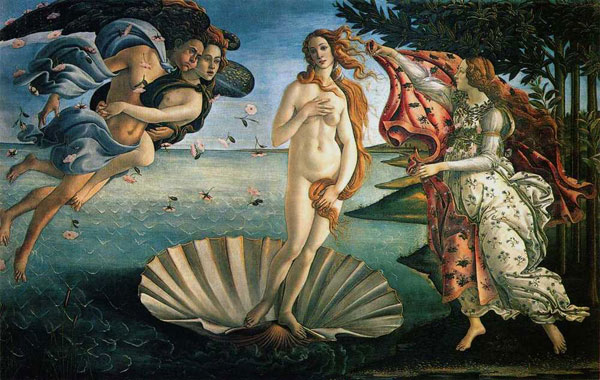The Birth of Venus by Botticelli

The Birth of Venus is undoubtedly one of the world’s most famous and appreciated works of art. Painted by Sandro Botticelli between 1482 and 1485, it has become a landmark of XV century Italian painting, so rich in meaning and allegorical references to antiquity.
The theme comes from Ovid’s Metamorphoses, a very important oeuvre of the Latin literature. Venus is portrayed naked on a shell on the seashore; on her left the winds blow gently caressing her hair with a shower of roses, on her right a handmaid (Ora) waits for the goddess to go closer to dress her shy body. The meadow is sprinkled with violets, symbol of modesty but often used for love potions.
We can find clear references to the “Stanzas”, a famous poetic work by Agnolo Poliziano, a contemporary of Botticelli and the greatest Neoplatonic poet of the Medici court. Neoplatonism was a current of thought that tried to connect the Greek and Roman cultural heritage with Christianity.
The Neoplatonic philosophical meaning is then clear: the work would mean the birth of love and the spiritual beauty as a driving force of life.
The iconography of Venus is certainly derived from the classic theme of Venus Pudica, covering her private parts shyly. In Florence, another important work of art is the translation in sculpture of the same theme: the famous Medici Venus at the Uffizi Gallery.
The Medici commissioned the Birth of Venus, including the works Pallas and the Centaur and the Allegory of Spring at the Uffizi, and these belonged to Lorenzo di Pierfrancesco de’ Medici, a cousin of Lorenzo the Magnificent.
As Poliziano was a great poet of written verses, so Botticelli was one of the greatest poets of the line and the drawing. It is worth to mention the exceptional technique and the fine materials used to accomplish the work. The Birth of Venus is the first example in Tuscany of a painting on canvas. Moreover the special use of expensive alabaster powder, making the colors even brighter and timeless, is another characteristic that makes this work unique.
Behind the interpretation of the painting as a tribute to classic literature, we can certainly read an ode to the wealthy Florentine family who commissioned the work: the beginning of the reign of love finally comes to Florence thanks to the Medici, their diplomatic skills and their vast culture.
This way Sandro Botticelli gives the art history one of its most sublime masterpieces.
Rooms 10-14 are dedicated to works by Botticelli; you’ll also find his famous Allegory of Spring, or Primavera, in this large room.









